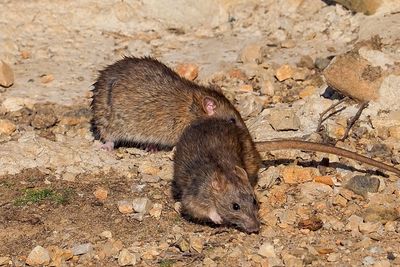Norway Rat Behavior, Morphology & Abilities in Boston
Learn about Norway rat morphology, behavior, and impressive survival abilities. Understand why these
Norway Rats in Boston: Anatomy, Habits & Urban Survival Skills
Norway rats (Rattus norvegicus), commonly referred to as brown rats or sewer rats, represent the most prevalent rat species infesting Boston’s neighborhoods, alleyways, basements, and sewers. Understanding their morphology, rat behavior, and physical abilities is crucial for effective rodent control and prevention in Boston’s high-density urban areas.
What Do Norway Rats Look Like?
Norway rats are stocky, powerful rodents with the following distinct physical traits:
Body Length: 7 to 10 inches long, not including the tail
Tail: Scaly, shorter than the body, and around 6 to 8 inches
Weight: 300–500 grams (up to 1 pound)
Color: Coarse brown or gray fur with a lighter underbelly
Head: Blunt snout, small ears, and beady black eyes
Their robust build and powerful limbs make them highly effective burrowers and climbers—perfectly adapted to survive in Boston’s aged infrastructure and dense building environments.
Norway Rat Behavior in Boston
These rats are primarily nocturnal, thriving in the shadows of Boston’s back alleys, sewers, and basements. Their behavioral traits include:
Burrowing: Norway rats dig extensive tunnel systems in loose soil, foundations, and under sidewalks. Back Bay, South End, and East Boston show especially high burrow activity.
Territoriality: Norway rats establish well-defined territories with shared food sources, nesting areas, and travel paths.
Social Structure: They live in hierarchical colonies—dominant males have access to better nesting and food.
Breeding: A single female can produce up to 6 litters per year, with 6–12 pups per litter. Populations spike rapidly in areas with poor trash management.
Abilities That Make Norway Rats Hard to Control
Norway rats are astonishingly adaptable, showcasing urban survival skills that make them difficult to eliminate in Boston:
Gnawing Power: Their incisors grow continuously and can chew through wood, plastic, aluminum, and even concrete.
Swimming Ability: They can tread water for up to 3 days and swim over a mile. Many infestations in Boston start in sewer lines and emerge through toilets and broken pipes.
Jumping & Climbing: They can leap 3 feet vertically and scale rough walls and pipes with ease.
Memory & Learning: Norway rats remember pathways, avoid new objects (neophobia), and learn to avoid traps if they see others die from them.
Scent Marking & Communication: They use pheromones and urine to mark trails and alert others to food or danger.
Why Norway Rats Thrive in Boston
Boston’s historic infrastructure, abundant restaurant waste, and aging sewer systems create ideal conditions for rat populations. High-density areas like Downtown Crossing, Back Bay, Fenway, and Allston-Brighton report some of the highest levels of Norway rat activity year-round.
Key factors include:
Cracked foundations and basements
Overflowing dumpsters and curbside trash
Abandoned lots and overgrown vegetation
Inadequate waste storage in commercial kitchens
Control Strategies
To manage Norway rat populations in Boston:
Seal all entry points larger than ¼ inch
Use secure, rodent-proof trash containers
Eliminate outdoor water sources and food waste
Deploy snap traps and bait stations along active runways
Schedule regular inspections and integrated pest management (IPM) services

This website uses cookies.
We use cookies to analyze website traffic and optimize your website experience. By accepting our use of cookies, your data will be aggregated with all other user data.